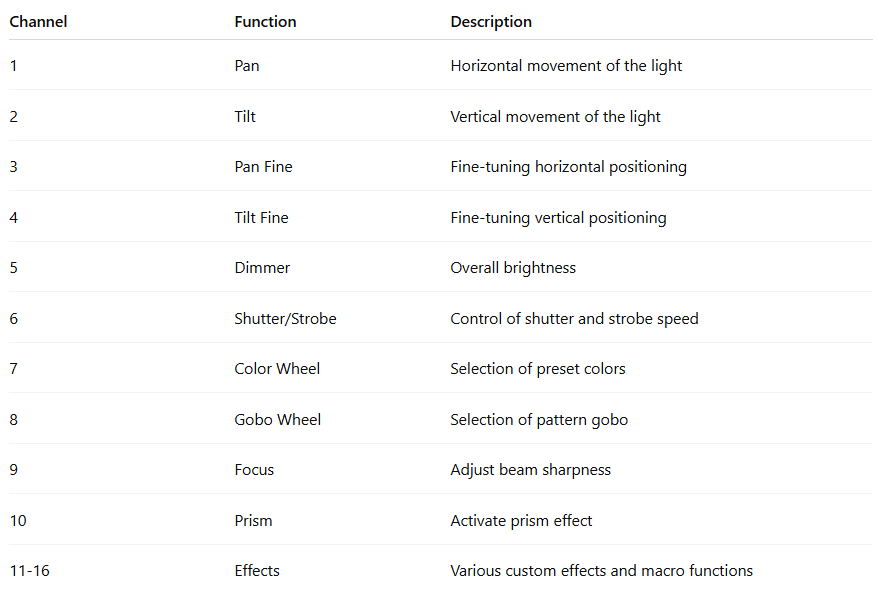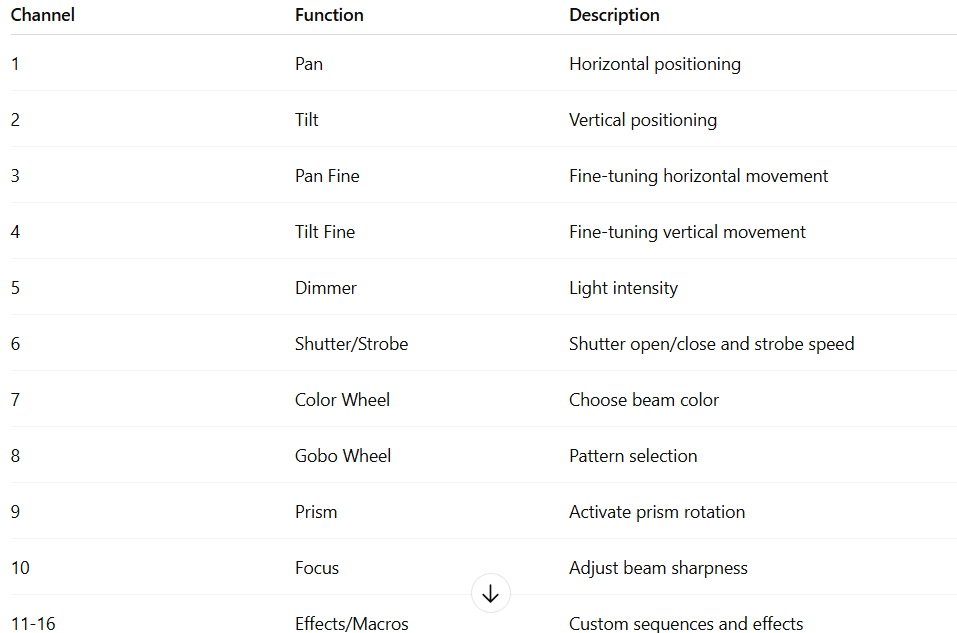In the world of professional stage lighting, moving head wash lights play a pivotal role in creating dynamic, immersive, and visually captivating experiences. From concerts and theater productions to DJ setups and live events, these versatile fixtures allow lighting designers to achieve smooth color transitions, complex effects, and precise beam control. However, to fully unlock the potential of moving head wash lights, understanding DMX channels is crucial.
DMX, short for Digital Multiplex, is the universal protocol used to control lighting fixtures, enabling precise manipulation of individual functions such as pan, tilt, color, gobo, and effects. A well-programmed DMX setup ensures consistent performance, seamless transitions, and creative freedom for lighting professionals. Leading manufacturers like Rasha Professional - professional stage lighting and manufacturer provide fixtures optimized for DMX control, offering a wide array of channel configurations that cater to both beginner and advanced users.
In this comprehensive guide, we will explore what DMX channels are, how to address them correctly, common functions in moving head wash lights, programming techniques, best practices, and answers to frequently asked questions. Whether you are a professional lighting technician or an aspiring DJ, this guide will help you master DMX control for moving head wash lights.
What are DMX Channels?
DMX channels are the individual communication pathways through which a lighting console or controller sends commands to a fixture. Each channel corresponds to a specific function, such as adjusting the pan, tilt, intensity, color, gobo selection, or strobe speed.
The DMX512 protocol, standardized in 1986, allows for up to 512 channels per universe, enabling complex setups with multiple fixtures. Each fixture is assigned a block of channels, allowing it to respond to specific signals from the controller.
For example, a 16-channel moving head wash light might use channels as follows:

Example: If channel 5 (Dimmer) is set to 255 (maximum value), the moving head wash will operate at full brightness. Adjusting channel 7 will change the color of the light beam instantly.
DMX channels enable lighting designers to orchestrate multiple fixtures simultaneously, creating stunning visuals synchronized to music, stage movement, or automated sequences.
Understanding DMX Addressing
DMX addressing determines the starting channel for a fixture within a DMX universe. Proper addressing ensures that each moving head wash responds to the correct commands without overlapping or conflict with other fixtures.
How DMX Addressing Works
- Identify the number of channels your fixture requires. A moving head wash light may use 8, 12, or 16 channels depending on its complexity.
- Assign a unique starting address for each fixture in the DMX chain. For instance, the first fixture could start at channel 1, the second at channel 17 (for a 16-channel fixture), the third at 33, and so on.
- Use DMX controllers or onboard menus to set addresses. Many fixtures, including Rasha Professional models, feature intuitive digital displays for easy addressing.
Example:
- Fixture 1: Start address 1 (channels 1–16)
- Fixture 2: Start address 17 (channels 17–32)
- Fixture 3: Start address 33 (channels 33–48)
Tips for Correct Addressing
- Always check the total number of channels required per fixture.
- Maintain consistency in channel assignment to simplify programming.
- Label cables and fixtures to prevent confusion during setup.
DMX Universe Concept
A DMX universe comprises 512 channels. If your setup exceeds this limit, you need multiple universes, which may require advanced controllers or software to manage cross-universe communication efficiently.
Common DMX Channel Functions in Moving Head Wash Lights
Moving head wash lights are versatile, and each DMX channel controls a specific function. Understanding these functions allows you to create precise lighting designs.
Pan/Tilt
- Function: Moves the light horizontally (pan) or vertically (tilt).
- Control: Channels 1–4 (Pan/Tilt + Fine) for precision.
- Use Case: Tracking a performer across the stage or creating sweeping effects.
Color Control
- Function: Changes the color of the light beam using RGB mixing or color wheels.
- Control: Channels 5–7 depending on fixture design.
- Example: RGB LED moving head wash allows full spectrum color mixing.
Gobo
- Function: Projects patterns onto surfaces using gobo wheels.
- Control: Specific DMX channels assigned to select, rotate, or animate gobos.
- Use Case: Enhance visual storytelling in theater or stage performances.
Dimmer and Shutter/Strobe
- Dimmer: Controls overall brightness.
- Shutter/Strobe: Creates flickering, strobe effects, or instant blackout.
- Control: Dedicated channels, often adjustable in 8-bit or 16-bit resolution.
Focus and Effects
- Focus: Adjusts beam sharpness for precise illumination.
- Effects: Includes prism rotation, frost filters, zoom, or macros.
Example Table: Advanced DMX Functions

Programming and Controlling Moving Head Wash Lights
Proper programming allows you to control multiple moving head wash fixtures simultaneously.
Using a DMX Controller
- Connect fixtures to the controller using DMX cables.
- Assign addresses to each fixture.
- Program sequences for desired effects: pan/tilt movements, color transitions, gobo rotations, dimming, and strobe patterns.
Example: A concert setup with 12 moving head wash lights can use a DMX controller to:
- Sweep lights across the stage in synchronization with music.
- Change colors based on song intensity.
- Trigger strobe effects during high-energy sections.
Using Software Controllers
Many modern setups use software-based DMX control, offering advanced visualization and programming features:
- Drag-and-drop fixture control.
- Pre-built effect libraries.
- Real-time monitoring of fixture responses.
Tips for Effective Control
- Start with simple sequences and gradually introduce complexity.
- Test each fixture individually to ensure proper addressing.
- Use Rasha Professional fixtures for consistent DMX responsiveness.
Advanced Tips and Best Practices
To optimize your DMX-controlled moving head wash setup:
Fixture Management
- Group fixtures with similar functions for synchronized control.
- Label cables and patch charts to simplify troubleshooting.
Channel Efficiency
- Use fewer channels when possible to leave room for expansion.
- Consider using multi-function macros to reduce programming complexity.
Maintenance
- Regularly inspect cables and connectors to prevent signal loss.
- Clean lenses and gobos for optimal light quality.
Statistics
- Proper DMX addressing reduces fixture errors by up to 90% in multi-fixture setups.
- Using 16-bit fine control improves precision by 256 times compared to 8-bit control.
Frequently Asked Questions (FAQs)
Q1: What is the difference between 8-bit and 16-bit DMX channels?
- Answer: 8-bit offers 256 levels per channel, while 16-bit provides 65,536 levels, allowing smoother movements and finer control of dimming or pan/tilt.
Q2: How do I set DMX addresses for multiple moving head wash lights?
- Answer: Assign each fixture a unique starting channel, taking into account the number of channels per fixture. Use digital displays on the fixture for accurate settings.
Q3: Can I control RGB colors and effects with fewer DMX channels?
- Answer: Yes, some fixtures combine multiple functions per channel, though it reduces independent control.
Q4: How do I troubleshoot a moving head fixture not responding to DMX?
- Answer: Check cable connections, verify addressing, inspect DMX polarity, and test with a different controller or fixture.
Q5: How many moving head lights can I connect to one DMX universe?
- Answer: Maximum 512 channels per universe. Divide total channels per fixture into 512 to calculate maximum fixtures.
Q6: What DMX channels are critical for professional stage lighting setups?
- Answer: Pan, tilt, dimmer, color, gobo, and strobe are essential for dynamic lighting effects.
Conclusion
Mastering DMX channels in moving head wash lights is essential for professional lighting design. From understanding individual channel functions to programming sequences and troubleshooting, every detail contributes to creating stunning stage visuals. By following best practices and using high-quality fixtures like Rasha Professional - professional stage lighting and manufacturer, lighting designers can achieve precision, flexibility, and creativity in any production.
Whether you are programming a single fixture or orchestrating a complex multi-fixture setup, a solid understanding of DMX channels ensures smooth operation, vibrant lighting effects, and a memorable experience for performers and audiences alike.

